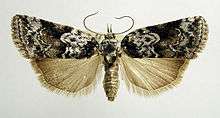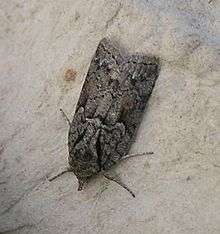Nycteola degenerana
Nycteola degenerana, the sallow nycteoline, is a moth of the family Nolidae. The species was first described by Jacob Hübner in 1799. It is found in Europe, from southern Fennoscandia to Spain, Italy and the Balkans. Outside of Europe it is found in China, Japan, the Korean Peninsula, the Russian Far East (Primorye, southern Khabarovsk and the southern Amur region), southern Siberia (Transbaikalia, the Baikal area, Altai and western Siberia), Turkey and the Ural.
| Nycteola degenerana | |
|---|---|
 | |
 | |
| Scientific classification | |
| Kingdom: | Animalia |
| Phylum: | Arthropoda |
| Class: | Insecta |
| Order: | Lepidoptera |
| Superfamily: | Noctuoidea |
| Family: | Nolidae |
| Genus: | Nycteola |
| Species: | N. degenerana |
| Binomial name | |
| Nycteola degenerana (Hübner, 1799) | |
| Synonyms | |
| |
The wingspan is 23–28 mm.It is the largest species of the genus. The palps are usually pure white. The ground colour of the forewings is greenish white to off-white with distinct black double lines shades and wavy black lines and spots in the basal area. The front half of the discal area with reddish-brown intermingling. Certain determination only by genitalic examination.
Adults are on wing from mid-June to the beginning of July and from the end of July (after overwintering) to May. There are two generations per year.
The larvae feed on Salix (including S. caprea, S. aurita, S. cinerea, S. myrsinifolia and S. phylicifolia) and Quercus robur.
External links
| Wikimedia Commons has media related to Nycteola degenerana. |
- Kimber, Ian. "(B105) BF2424 Sallow Nycteoline Nycteola degenerana (Hübner, [1799])". UKMoths. Retrieved 4 July 2019.
- Korean Insects
- Swedish Moths
- Lepiforum e.V.